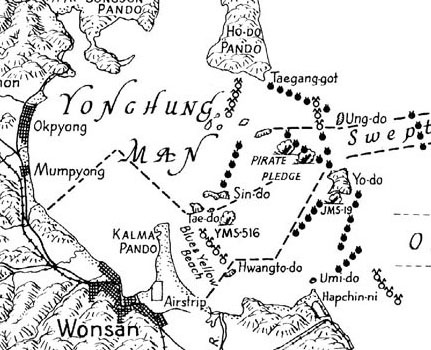
DEPARTMENT OF THE
NAVY -- NAVAL HISTORICAL CENTER
Shore
Fire Control Parties on Hwangto-do
Perhaps the most useful of the Wonsan harbor islands for
the siege ships was the island of Hwangto-do, one of three
islands used for the spotting of ships' gunfire. The barren
and rocky island, without a single tree, had an elevation
of 160 feet, and was only 3,000 yards from the shore, and
therefore closest to enemy guns and mortars. Hwangto-do
was also closest to the city of Wonsan, to the much-battered
Wonsan airfield, and to the important road running southward
to the front through the Anbyon Valley. This road was the
enemy's main supply route in the eastern sector. From the
observation post atop Hwangto-do, spotters could look directly
upon Wonsan, the Anbyon Valley road, and several important
bridges along this railroad and highway.
Until
June 1951, Hwangto-do could only be approached in sampans*
because of the mine danger. Sampans were not endangered
because the mines were anchored six to ten feet beneath
the sea surface and below their keels. Because of the island's
proximity to enemy gunfire, all movement to and from this
island was at night. A Korean Marine Corps LCVP was used
to carry food and other supplies to the other "friendly"
islands but had not been used to supply Hwangto-do. (*Small
wooden fishing boats with shallow draft)
It was brought out that the gunfire support might be more
effective with a Shore Fire Control Party stationed close
in to the targets. I assured them that the island of Hwangto-do
could be used for this purpose and would be an ideal location.
We
made out a list of the things the party should take with
them. Included was all the food they would use, the kind
of clothing and bedding, the kinds and numbers of weapons,
and the amount of ammunition and the radio gear most suitable.
The party could expect to be under close, accurate enemy
artillery and mortar fire, and, of course, there was the
ever-present threat of an enemy landing. Raiding sampans
coming out from the south couldn't be detected by radar
from the siege ships, and the ships would be unable to take
them under fire when they were close to the island.
I took them into Hwangto-do in one of the destroyer's whaleboats
and got them 'squared away'. The whaleboat carried a radar
reflecting screen, and the ships kept a close watch on our
progress. We landed on the only beach on the island. This
beach was on the west side of the island and was very exposed
to enemy fire. The rest of the island coast was rough rock
and couldn't be approached because of under-water rocks.
Nearby was a cluster of ten fishing huts.
The shore fire control party holed up in one of the fishing
huts. The Korean Marine Corps garrison platoon was most
happy to have them on the island.
next page
 "The
Fightin' Floyd B"
"The
Fightin' Floyd B"

